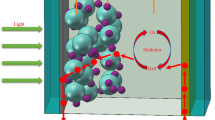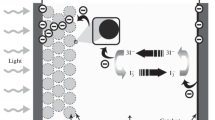Abstract
This work mainly investigates the radiation effects and the damage mechanism on the dye-sensitized solar cells (DSSCs) irradiated by two dose rates of 60Co γ-rays. Experimental results reveal that the performance of DSSC decreases significantly after irradiation, and the degradation rates of the short circuit current and the maximum power in the high dose rate both outweigh those in the low dose rate at the same adsorbed dose. The γ radiation effects on fluorine-doped tin oxide (FTO) and electrolyte were also studied respectively to investigate the degradation rates of DSSC at different dose rates. The results indicate that the degradation rates are closely relative to concentration of γ irradiation-induced defect on FTO.







Similar content being viewed by others
References
Rong W, Zengliang G, Xinghui Z, Zuoxu Z (2003) 5–20 MeV proton irradiation effects on GaAs/Ge solar cells for space use. Sol Energy Mater Sol Cells 77(4):351–357
Messenger SR, Summers GP, Burke EA, Walters RJ, Xapsos MA (2001) Modeling solar cell degradation in space: a comparison of the NRL displacement damage dose and the JPL equivalent fluence approaches. Prog Photovoltaics Res Appl 9(2):103–121
Karam NH, King RR, Haddad M et al (2001) Recent developments in high-efficiency Ga 0.5 In 0.5 P/GaAs/Ge dual-and triple-junction solar cells: steps to next-generation PV cells. Sol Energy Mater Sol Cells 66(1):453–466
Anspaugh BE (1996) GaAs solar cell radiation handbook. Createspace Independent Publication, North Charleston
Tüzün Ö, Altındal Ş, Oktik Ş (2008) Effects of illumination and 60Co γ-ray irradiation on the electrical characteristics of porous silicon solar cells. Renew Energy 33(2):286–292
Ali K, Khan SA, MatJafri MZ (2013) 60Co γ-irradiation effects on electrical characteristics of monocrystalline silicon solar cell. Int J Electrochem Sci 8:7831–7841
Summers GP, Burke EA, Shapiro P, Messenger SR, Walters RJ (1993) Damage correlations in semiconductors exposed to gamma, electron and proton radiations. IEEE Trans Nucl Sci 40(6):1372–1379
Yamaguchi M (2001) Radiation-resistant solar cells for space use. Sol Energy Mater Sol Cells 68(1):31–53
Matsuura H, Iwata H, Kagamihara S (2006) Si substrate suitable for radiation-resistant space solar cells. Jpn J Appl Phys 45(4R):2648
Maximenko SI, Messenger SR, Cress CD et al (2010) Application of CL/EBIC-SEM techniques for characterization of radiation effects in multijunction solar cells. IEEE Trans Nucl Sci 57(6):30
O’Regan B, Grätzel M (1991) A low-cost, high-efficiency solar cell based on dye-sensitized colloidal TiO2 films. Nature 353(6346):737–740
Bessho T, Zakeeruddin SM, Yeh CY et al (2010) Highly efficient mesoscopic dye-sensitized solar cells based on donor-acceptor-substituted porphyrins. Angew Chem Int Ed 49(37):6646–6649
Kakiage K, Aoyama Y, Yano T, Oya K, Fujisawa J, Hanaya M (2015) Highly-efficient dye-sensitized solar cells with collaborative sensitization by silyl-anchor and carboxy-anchor dyes. Chem Commun 51(88):15894–15897
Liu M, Tang X, Liu Y et al (2016) A study on the variation of dye-sensitized solar cell parameters under γ irradiation. J Radioanal Nucl Chem 308(2):631–637
Gregg BA, Hanna MC (2003) Comparing organic to inorganic photovoltaic cells: theory, experiment, and simulation. J Appl Phys 93(6):3605–3614
McGrath B, Schönbacher H, Van de Voorde M (1976) Effects of nuclear radiation on the optical properties of cerium-doped glass. Nucl Instrum Methods 135(1):93–97
Nikl M, Nitsch K, Mihokova E et al (2000) Efficient radioluminescence of the Ce3+-doped Na–Gd phosphate glasses. Appl Phys Lett 77(14):2159–2161
Acknowledgements
This work was supported by the National Natural Science Foundation of China (Grant Nos. 11675076 and 11505096), the Natural Science Foundation of Jiangsu Province (Grant No. BK20150735), the Funding of Jiangsu Innovation Program for Graduate Education (Grant No. KYLX16_0354), the National Defense Basic Scientific Research Project (Grant No. JCKY2016605C006) and the Priority Academic Program Development of Jiangsu Higher Education Institutions.
Author information
Authors and Affiliations
Corresponding author
Rights and permissions
About this article
Cite this article
Zhang, Z., Tang, X., Liu, Y. et al. A study on the degradation of dye-sensitized solar cells irradiated by two different dose rates of γ-rays. J Radioanal Nucl Chem 312, 609–614 (2017). https://doi.org/10.1007/s10967-017-5262-6
Received:
Published:
Issue Date:
DOI: https://doi.org/10.1007/s10967-017-5262-6




